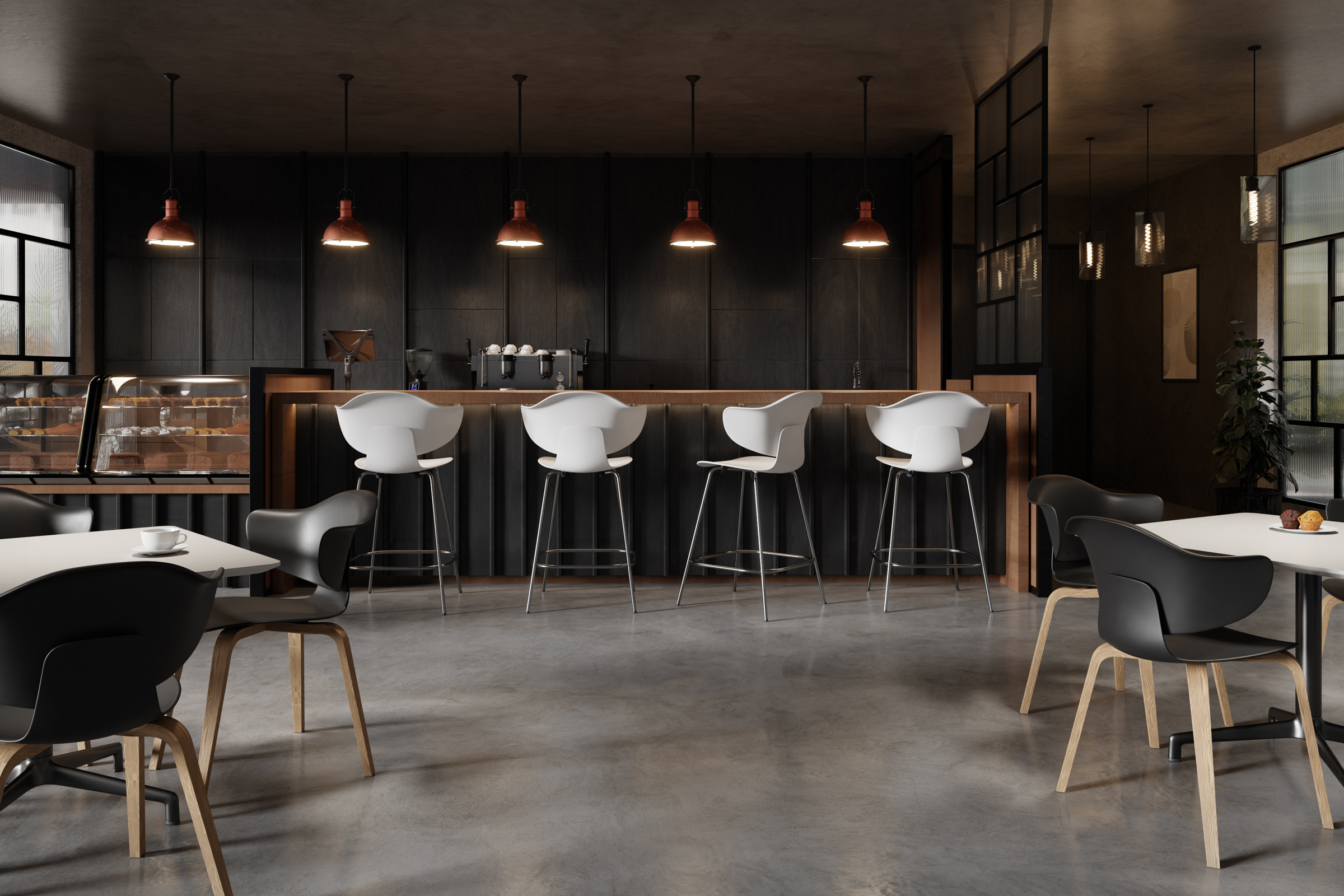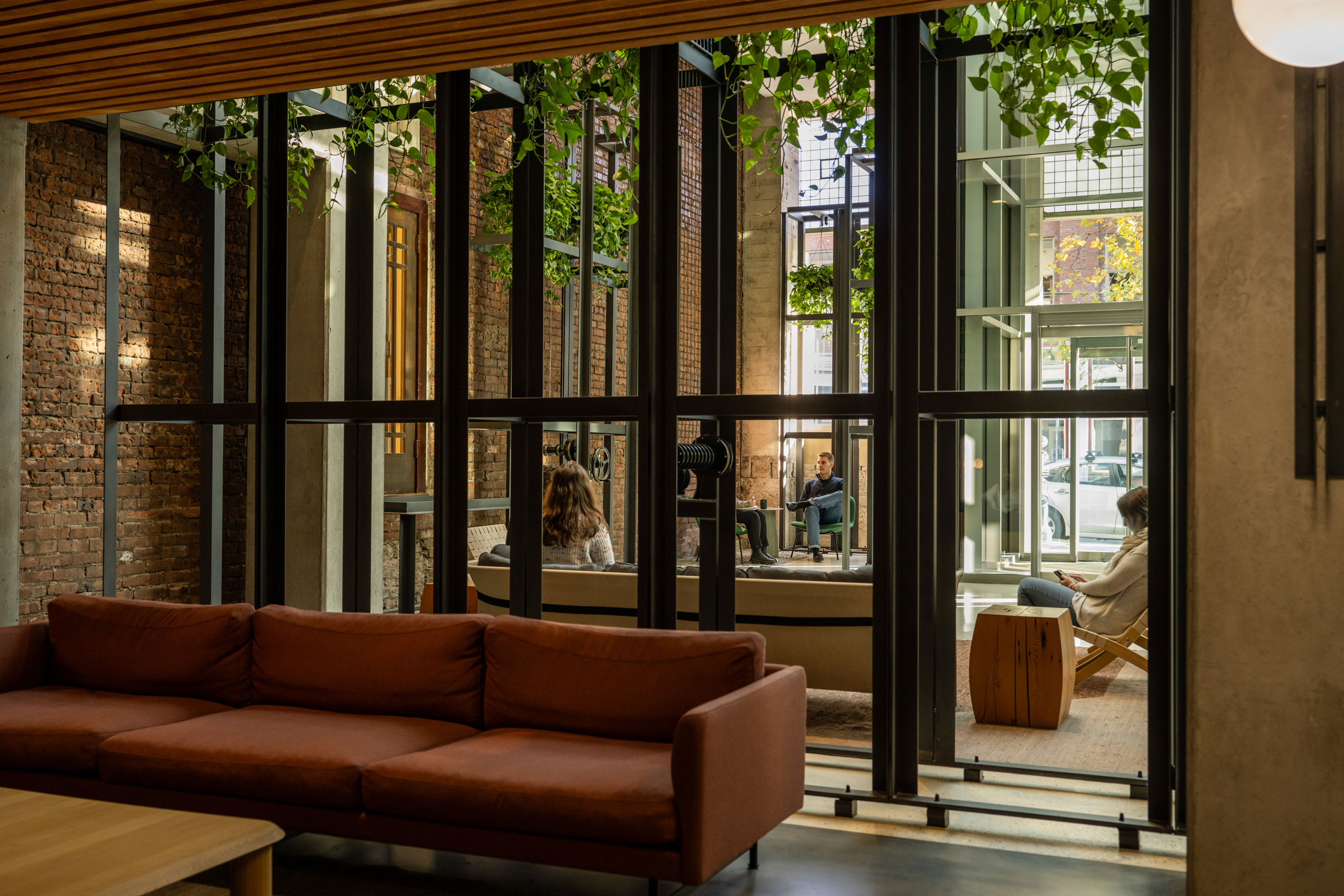Story at a glance:
- Sustainable furniture companies share a commitment to products that take minimal energy and water to produce, use, and reuse.
- Many leading sustainable companies may use reclaimed wood, non-plastic alternatives, waste, or certified organic materials in their designs.
When it comes to green building and design, all aspects of a structure—inside and out—play a role in achieving its sustainability. Then there’s also its materials’ origins, manufacture, and reusability in a circular design that matter. It’s dizzying to contemplate all the pieces at one time. In this article we focus on the sustainable furniture inside green buildings.
Here are eight sustainable furniture companies.
What is Sustainable Furniture?
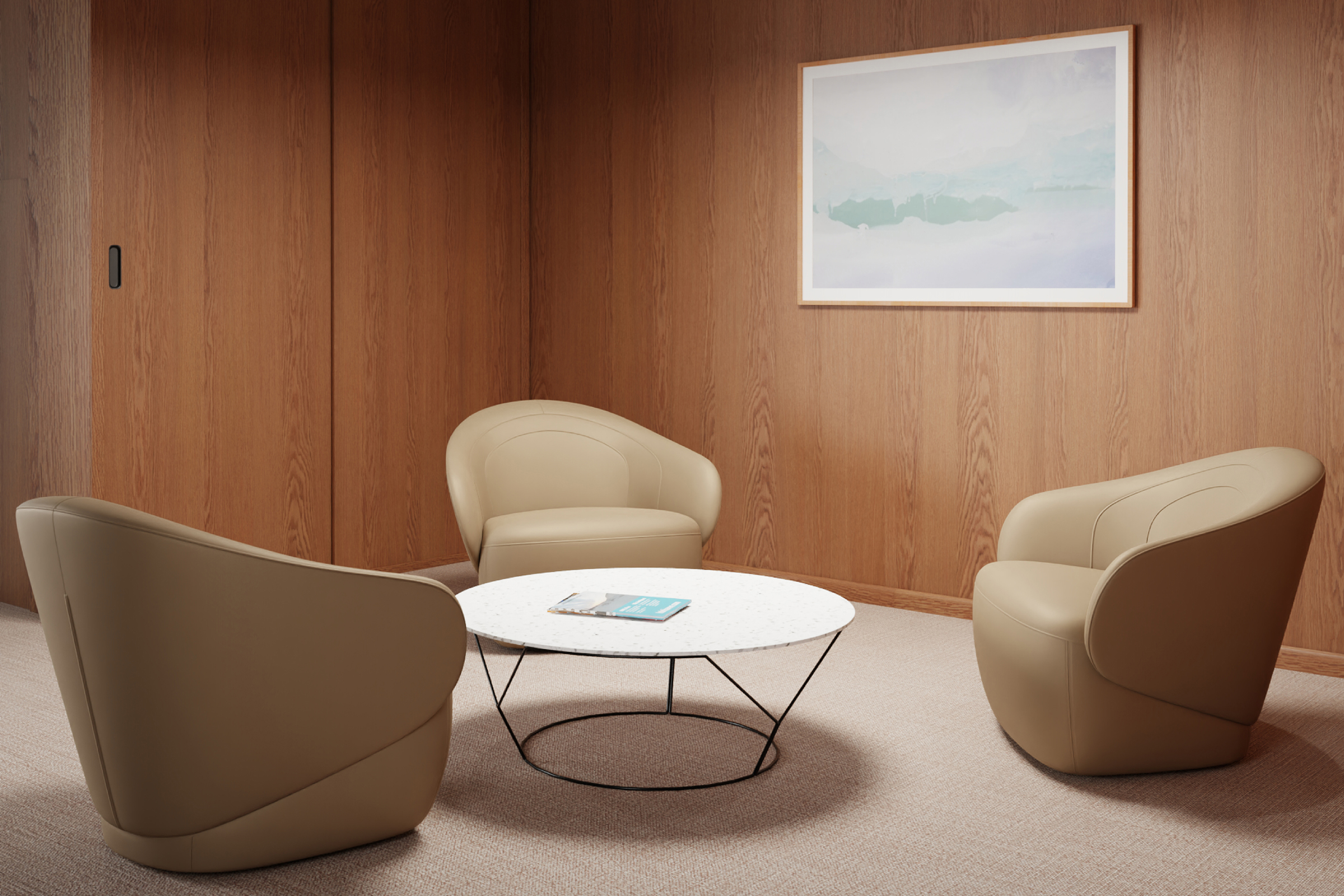
Keilhauer plans to make all of its contract furniture, including Swish (seen here) carbon neutral. Photo courtesy of Keilhauer
To arrive at a definition of sustainable furniture, it’s useful to begin with the central notion of sustainability itself.
“Sustainability is often described as ‘the ultimate team sport’ in the corporate world because we have to work cross-functionally with all departments—from accounting and finance to engineering, procurement, and operations and eventually to product development, marketing, and communications,” Josh Belczyk, sustainability officer for Keilhauer, told gb&d in a previous interview.
As Belczyk implies, all of a company’s departments are united in placing sustainability at their center. When considering a furniture company, here are a few specific ways they can ensure their products are sustainable.
- Commission an independent cradle-to-cradle life cycle assessment. Being sustainable involves looking ahead decades down the line and making sure a product- or its parts – are durable enough to be useful then.
- Use primarily recycled or reclaimed materials. Sustainable furniture companies must remain leagues above the fast furniture industry and never adopt their practices or anything resembling them.
- Minimize inventory available at any given time. Building to order, or specializing in customizable, handmade pieces, will reduce the need for storage and eliminate the risk of damage or loss.
8 Sustainable Furniture Companies
These eight sustainable furniture companies offer inspiring products for the office or home or virtually any commercial project.
1. Humanscale
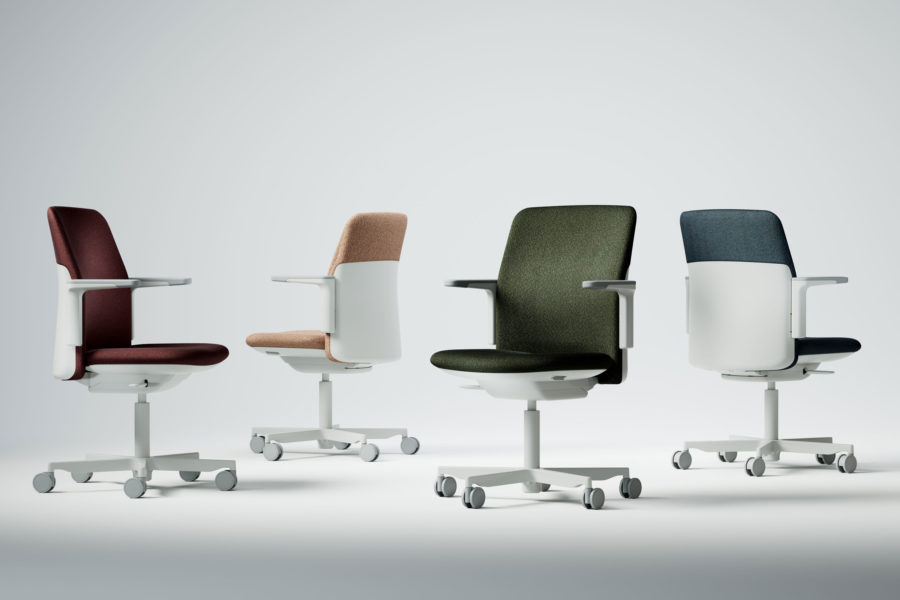
Humanscale calls its “Path” Chair the “most sustainable and ergonomically advanced task chair for every body.” Photo courtesy of Humanscale
A leading manufacturer of sustainable and ergonomic office furniture, Humanscale looks to make a net positive impact on both their customers and the planet. “Humanscale was founded on the idea that design has the potential to bring joy, health, and comfort to people’s lives,” Bob King, founder and CEO of Humanscale, told gb&d in a previous article. “Design must also play a critical role in reversing the damage done to our environment.”
This belief in regenerative design was central to Humanscale’s decision to pursue—and ultimately earn—Living Product Challenge (LPC) certification for 26 of their products. The LPC is a science-based holistic framework for creating socially and environmentally-sustainable products that are healthy, inspiring, and give more than they take away throughout their life cycles.
Humanscale’s pursuit of LPC certification in turn led to the development of a robust catalog of social and environmental sustainability initiatives—like a comprehensive cross-facility rainwater harvesting program, the publishing of ingredient Declare labels for the majority of their products, and extensive GHG emissions monitoring—as well as ambitious sustainability goals. Since 2022 Humanscale has diverted 94% of all their waste annually, putting them well on their way to achieving their ultimate goal of 100% waste diversion by 2030.
This overwhelming commitment to sustainability shines through in all Humanscale products, including, for example, their LPC-certified Path Chair. Constructed from ocean plastic, plastic bottles, and industrial plastic waste, the Path Chair contains more upcycled plastic waste than than any other chair on the market. “The Path chair represents ‘a new path forward’ in design, prioritizing the manufacturing of products that not only create comfortable, beautiful working environments, but also push forward our use of sustainable materials and manufacturing techniques,” King says.
2. MooreCo
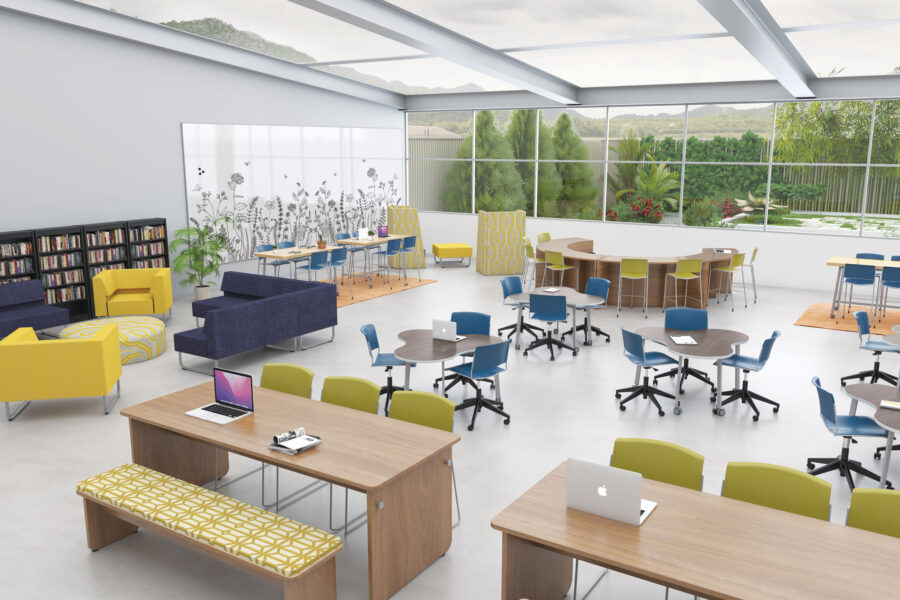
Learning environments benefit from flexible furniture setups and biophilic design strategies, as seen in this rendering by MooreCo. Rendering courtesy of MooreCo
MooreCo—a leading manufacturer of educational and commercial furniture—considers environmental awareness to be one of their core business practices and looks to promote sustainability up and down their value chain. Some of the company’s sustainability initiatives include:
- Processing scrap polyurethane and Styrofoam for use as fill materials in bean bag products
- Specifying recycled content in their purchased component parts
- Baling and selling excess polyurethane foam to be remanufactured into other foam products
- Sourcing hardwood only from reforested sources
- Using packaging materials that are composed of at least 25% recycled content
- Optimizing ground transportation routes to conserve fuel and reduce emissions
In addition to these initiatives, MooreCo also practices sustainability by designing furniture that is both durable and capable of serving multiple functions, reducing the overall material requirements for classroom spaces. “Being able to take one piece of furniture and use it in multiple ways without taking up three different spaces to do that in a classroom is cool but also really important to the students and teachers trying to use that space,” Molly Cox, design team manager for MooreCo, told gb&d in a previous publication.
3. KI

KI’s Ruckus Storage keeps what you need accessible but organized and is available in various heights and widths. Photo courtesy of KI
A leading designer and manufacturer of high-performance contract furniture, KI (KI) takes a three-pronged approach to sustainability:
- Manufacturing processes. KI strives to reduce its environmental impact at all stages of manufacturing by partnering with green energy providers, implementing quality management systems at their plants to ensure compliance with environmental ordinances and guidelines, using fuel-efficient vehicles for product transportation, and encouraging recycling of all packaging.
- Material selection. Where possible KI incorporates renewable and recyclable materials—like recycled aluminum and bio-based foam—into their products and packaging.
- Product design. All KI products are engineered with longevity in mind and are subject to a rigorous Design for the Environment (DFE) analysis; the DFE program helps KI minimize energy and water use, evaluate and improve recyclability and biodegradability, and reduce their products’ overall end-of-life environmental impact.
Building longevity into each of their products is of the utmost concern to KI and something they take very seriously. “The furniture has to stand the test of time, and that gets calculated into product design at the forefront,” Bryan Ballegeer, vice president of education markets at KI, previously told gb&d. “How that is done is through our incredible design team, engineering team, as well as my team and our product team doing research and understanding user needs and by building that quality and durability at the forefront.”
When KI products eventually reach the end of their operational lifespan, however, customers can refer to the company’s recovery options matrix for assistance in removing, repurposing, or reselling products; KI also provides all customers with disassembly instructions to facilitate ease of recycling.
In addition to being environmentally sustainable, KI is also socially sustainable, in large part thanks to its status as a 100% employee-owned business. Switching to an employee-owned model is proven to increase job tenure, with KI boasting an average tenure of 13 years—over three times that of the industry average. Keeping employees engaged and invested allows KI to retain their best talent for the long term, making for a more productive and profitable business.
KI’s ongoing commitment to community involvement further highlights their pursuit of social sustainability; the company supports a range of health and wellness programs, regional youth and family initiatives, educational programs, and environmental awareness/conservation efforts.
4. Keilhauer
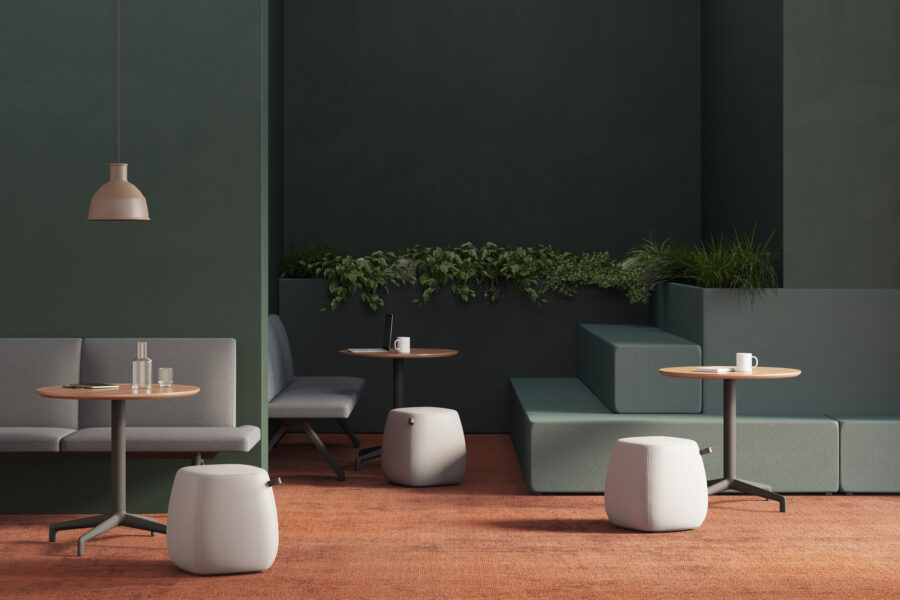
The whimsical Vagabond is the world’s first carbon neutral ottoman. Photo courtesy of Keilhauer
Making sustainable contract furniture that is carbon-neutral has always been the goal of Keilhauer. For this company, sustainable office chairs and tables begin with a cradle-to-grave life cycle assessment for every product concept.
“Since the company started we have worked on growing our sustainability practices and staying ahead of trends. It has always been important for us to do what is right, well before these metrics were in the spotlight,” Maggie Keilhauer, project manager at Keilhauer, told gb&d in a previous interview.
5. Avocado Green Mattress
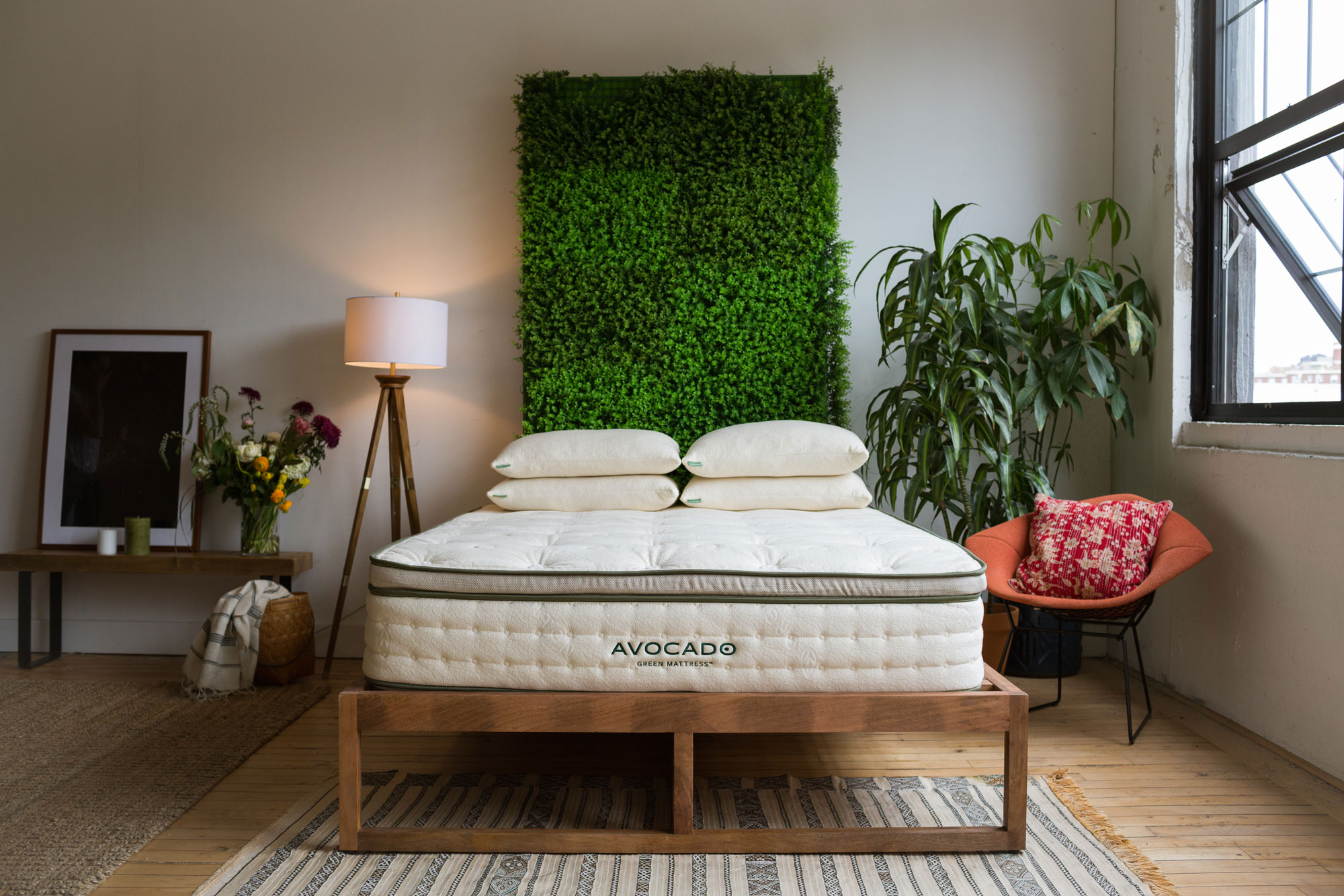
Avocado Green Mattress. Photo by Melissa Kruse
Sustainable in every sense of that word, Avocado mattresses are 100% “natural, safe, and responsible” as the family-owned business mantra dictates. Constructed out of 100% natural Dunlop latex rubber, pure Joma New Zealand wool, recycled-steel support coils, and premium GOTS-certified organic cotton, most of the mattress is biodegradable, a sustainability hallmark. Since wool is a natural flame retardant, there’s never a need to use toxic PBDEs to serve this function in an Avocado mattress. Bonus points given because Avocado waits until you order before making your mattress.
6. Jonti-Craft
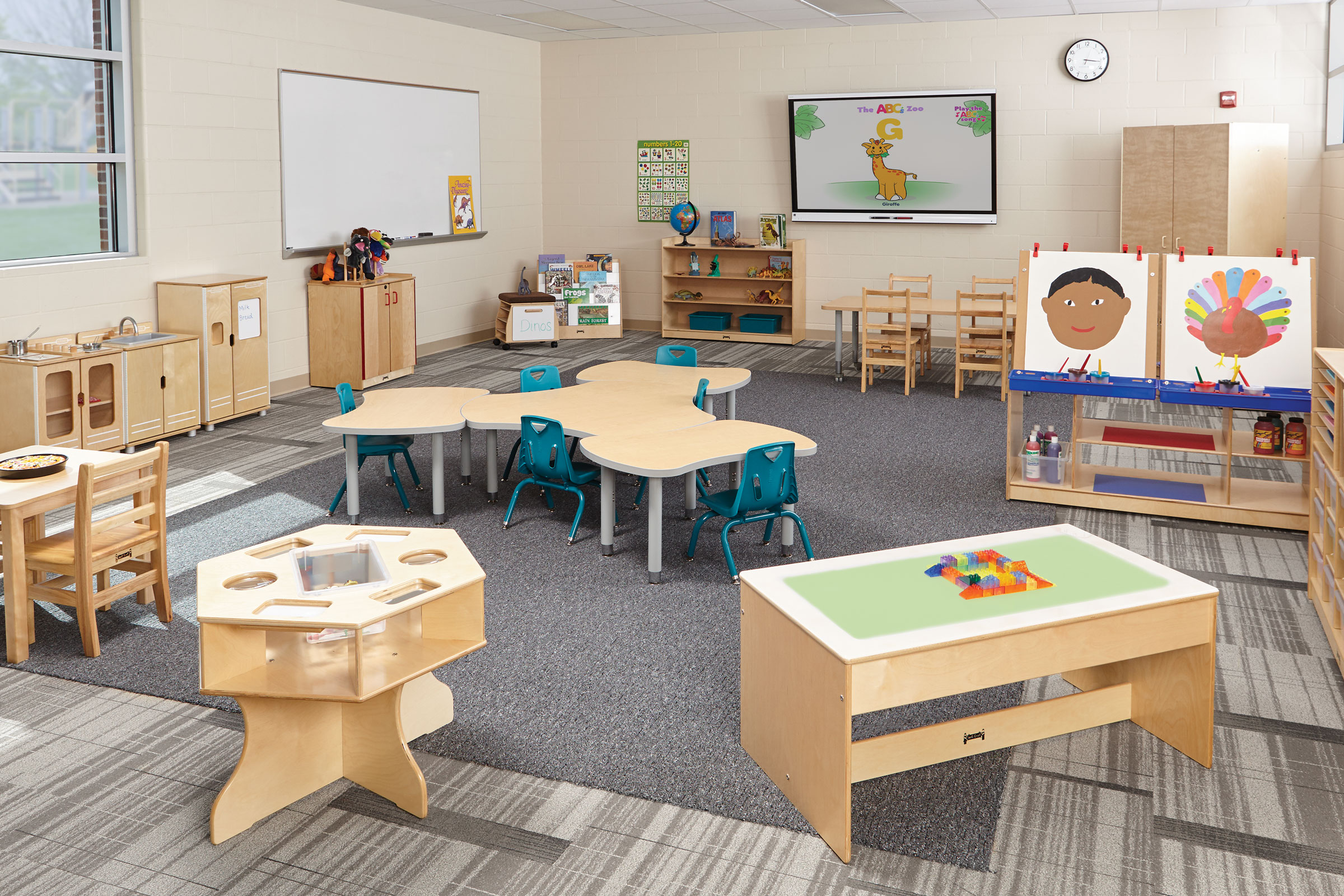
Jonti-Craft’s expansive collection of educational furniture—from colorful laminate options to sturdy Baltic Birch and modular lines—means there is an option for every learning space. Photo courtesy of Jonti-Craft
Healthy schools begin with nontoxic, sustainable classroom furniture constructed by Jonti-Craft. To complement their inside lines made of all wood, they now offer outdoor play equipment.
“Their products are durable, easy to keep clean, and the teachers love them,” classroom designer Susan Pinckney of TSKP Studio—a regular client for over a decade—told gb&d in a previous article. “Where other manufacturers tend to limit themselves, Jonti-Craft doesn’t. They have a really broad selection. You know everything will work together, coordinate, and last.”
She especially loves the fact that Jonti-Craft products met GREENGUARD Gold standards before that certification even existed.
7. Stickbulb
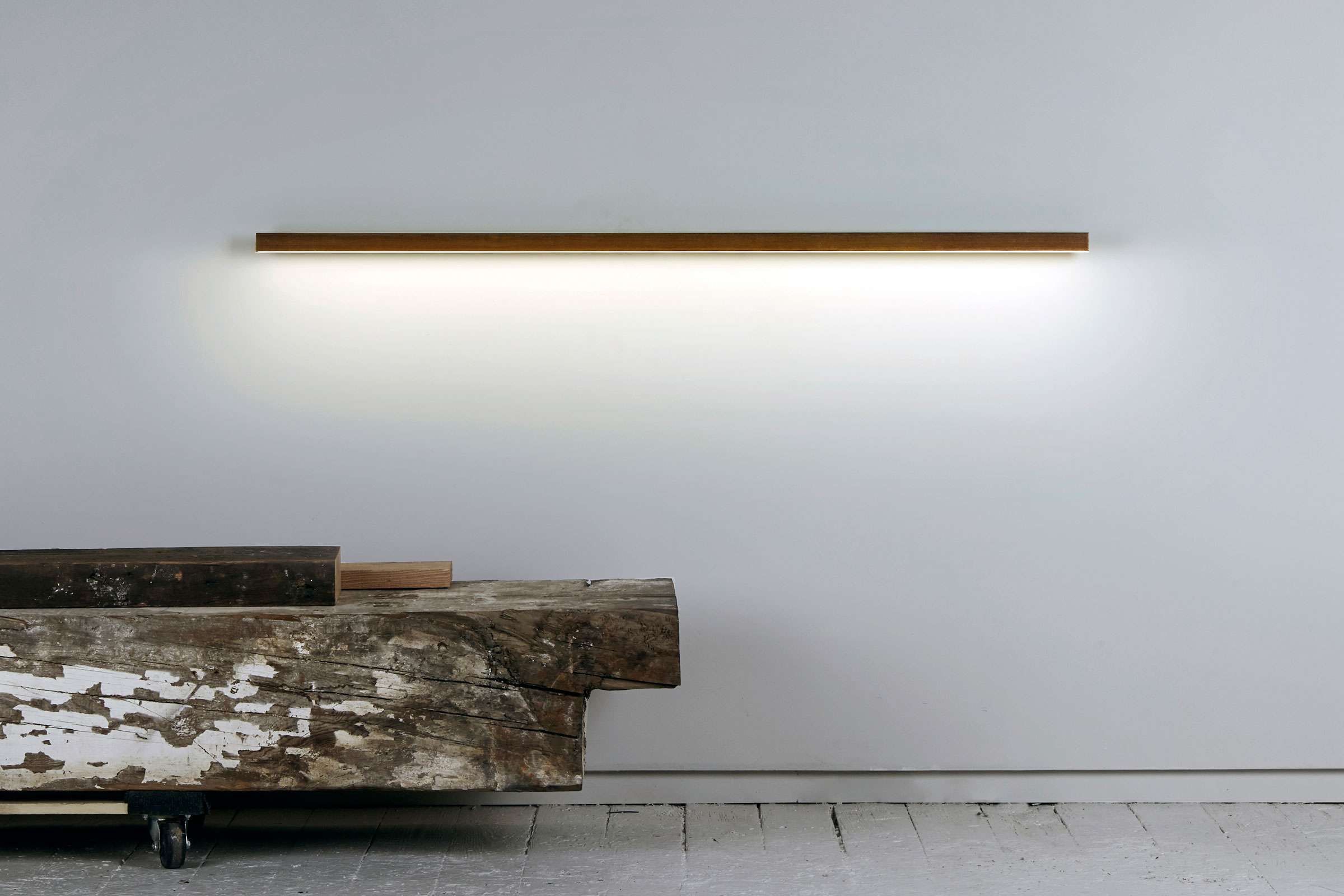
Stickbulb’s new RAY Sconce Collection incorporates sustainably sourced woods. Since its start Stickbulb’s mission has been to source only from demolished buildings, decommissioned water towers, trees that have already fallen down, and sustainably grown forests. Photo by Joseph De Leo
Founded in 2012 with the intention of designing truly sustainable lighting systems, Stickbulb specializes in low-impact LED light fixtures that are both versatile and energy efficient. This commitment to sustainability is most apparent in Stickbulb’s material sourcing practices.
All the wood used in their fixtures is locally sourced from demolished buildings, decommissioned NYC water towers, sustainably managed forests in New York and Pennsylvania, and—in the case of their TREELINE collection—salvaged trees removed from NYC’s urban forest. Each fixture is designed using the least amount of parts possible to help minimize waste and facilitate ease of recycling.
Giving materials a second chance at life is a concept that runs deeper than Stickbulb’s product model, as the company showroom, studio, and workshop are all located in a former iron factory building constructed over a century ago. The adaptive reuse of an existing building helps prevent significant amounts of demolition waste from being sent off to landfills and prevents the release of embodied carbon emissions.
Stickbulb is also Climate Neutral-certified through the Climate Change Project, signifying that the company has taken rigorous measures to measure, reduce, and compensate for all emissions associated with manufacturing and delivering their products.
8. Sabai

All Sabai products are made from sustainably-sourced natural materials and/or recycled materials. The Essential Sofa, for example, is upholstered in velvet made from recycled plastic bottles. Photo courtesy of Sabai
BIPOC-owned home furniture brand Sabai was founded on the belief that furniture can be both sustainable and affordable without posing a threat to human or environmental health. All Sabai products are free of toxic ingredients and manufactured from recycled or locally sourced materials—like hemp, rubberized coconut fiber, and muslin fabric—proven to be eco-friendly and durable. The Essential Sofa, for example, is upholstered in either 100% recycled velvet made from plastic water bottles or up-cycled polyester.
Sabai is also a major proponent of the circular economy, as evidenced by their Repair Don’t Replace (RDR) and Revive programs. As the name suggests, RDR makes it easy for customers to source replacement parts—like foam inserts, slipcovers, furniture legs, et cetera—for minor repairs and aesthetic revamps rather than buy an all-new piece of furniture, helping to keep their products in use and out of landfills.
In the event that a customer does need to part with their furniture for whatever reason, Sabai’s Revive program can help it find a new home. All one needs to do is fill out a buyback form, send photos to ensure the piece is in an adequate condition, and Sabai will list the piece at a reduced price to find a buyer. Once sold, Sabai helps the owner source boxes and schedule a pickup to ship the piece to its new owner; when possible, Sabai ships customer-to-customer to reduce transportation emissions.
In addition to environmental sustainability, social sustainability is another of Sabai’s guiding principles. All of their products are manufactured in ethically-run factories—each committed to worker safety and paying a living wage—in North Carolina, South Carolina, Tennessee, and Michigan.
Tips for Sustainable Interior Design
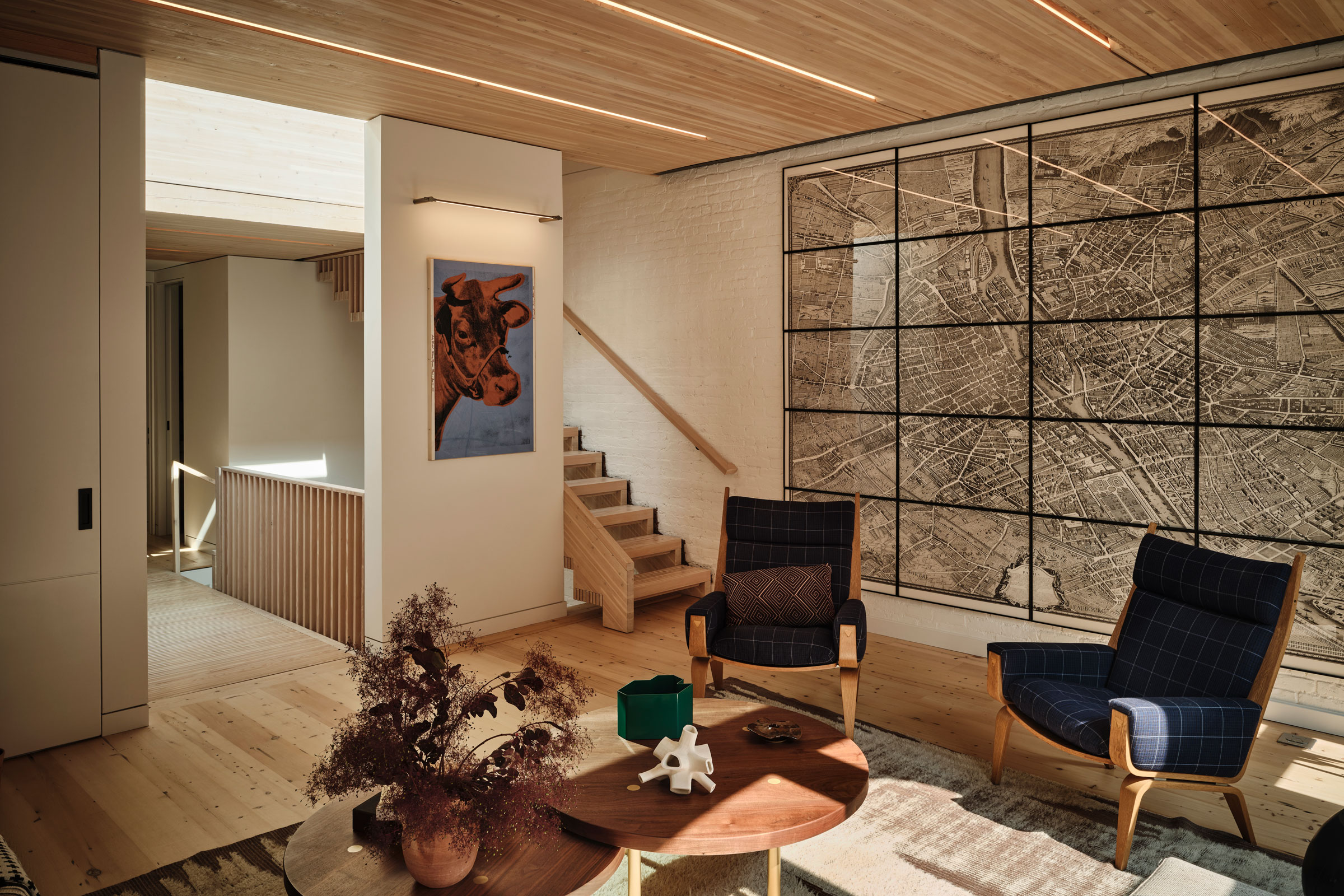
The living room of the Brooklyn Mass Timber House features floors recycled from the original timbers and integrated lighting from Stickbulb. Photo by Frank Frances
There are always more ways to practice sustainable interior design beyond the trite axiom: reduce, reuse, and recycle. Here are a few tips, especially when designing or selecting sustainable furniture.
- Include several gently used furniture pieces from vintage shops in your interior design. Not only will you be fully living in a circular design process. You’ll also be saving your client money.
- Develop databases of reputable sources of reclaimed wood, certified organic materials, recycled plastic manufacturers, etc., so they’ll be at your fingertips when you need them. Constantly update and expand the databases. Reach out to develop working relationships with company owners, and to find out what’s coming down the pipe related to their sustainable design material of choice.
- Embrace the notion of minimalism, inherent in sustainability, in your design. Preserving open spaces in a building by reducing the number of furniture pieces you include will release your clients from feeling encumbered by them.
Jeanne Yacoubou contributed to this article.

